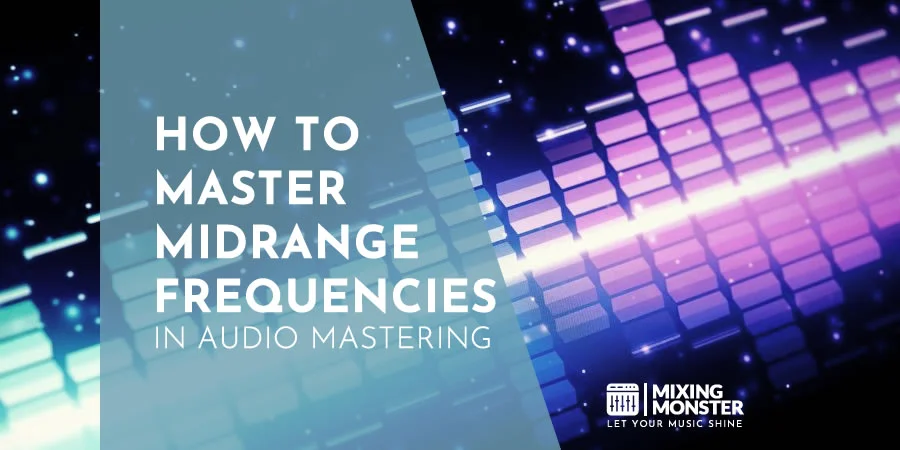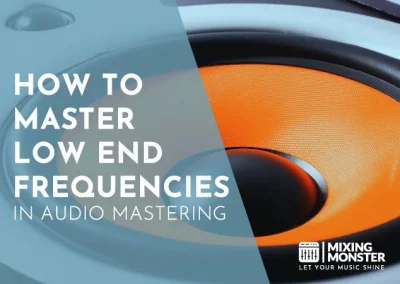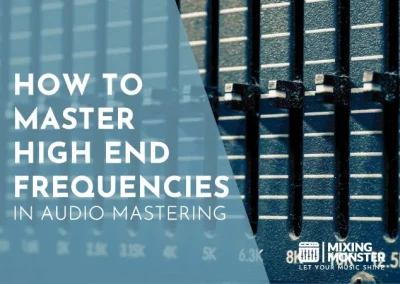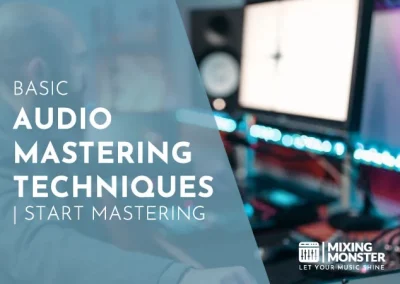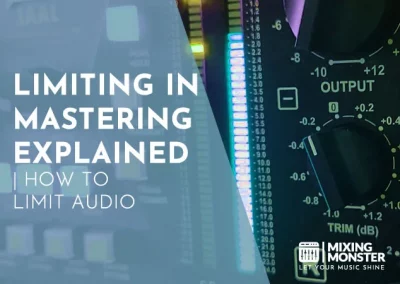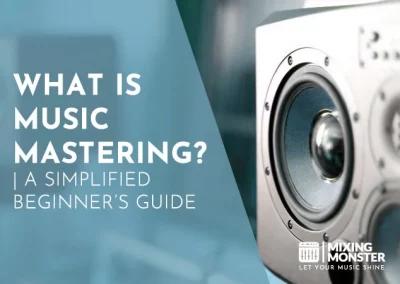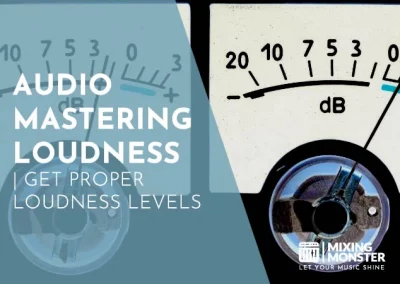Disclosure: Some of the links below are affiliate links, meaning that at no additional cost to you, we will receive a commission if you click through and make a purchase. Read our full affiliate disclosure here.
Learning how to master midrange in audio production is essential for achieving clarity and balance in your mix. Whether you’re an aspiring producer or an experienced engineer, understanding how to control and manipulate midrange frequencies can significantly enhance the playability and presence of your music. Midrange frequencies contribute to a sound’s ‘body’ and ‘punch,’ greatly influencing a track’s style and perceived warmth. They are crucial for the intelligibility of vocals, the fullness of guitars, and the definition of snare drums.
Proper midrange mastering allows for audio adjustments that ensure each element sits nicely in the mix without overshadowing others. Midrange frequencies, typically ranging from 250 Hz to 2000 Hz, can quickly become crowded or muddy if not appropriately mixed and mastered; thus, vigilance and precision in handling the midrange are critical to a professional-sounding mix.
Understanding the intricacies of midrange will empower you to craft mixes that sound full and polished on any playback system. You’ll learn the foundational aspects of assessing midrange frequencies and various techniques to shape them to perfection. Additionally, you’ll discover advanced processing tips to achieve midrange clarity and learn common mistakes to avoid. By mastering midrange, your mixes will stand out for their balance and cohesive sound.
KEY TAKEAWAYS:
- Mastering midrange enhances clarity and balance in a mix.
- Midrange control contributes to the warmth and presence of music.
- Techniques and tips are available for optimal midrange management in audio mastering.
Table Of Contents
1. Overview Of How To Master Midrange Frequencies
2. Assessing Midrange Frequencies In Your Mix
3. Techniques To Master Midrange
4. Advanced Processing Tips For Midrange Clarity
5. Common Midrange Mastering Mistakes To Avoid
6. Putting It All Together: Proper Midrange Mastering
7. FAQ

1. Overview Of How To Master Midrange Frequencies
In mastering audio, controlling midrange frequencies is vital to achieving clarity and balance in your sound.
Defining Midrange Frequencies
Midrange frequencies typically span from 200Hz to 5kHz. This spectrum houses the core of most musical instruments and the human voice. Mastering these frequencies involves careful adjustment to avoid muddiness while maintaining energy in the mix.
The Role Of Midrange In Audio Perception
Your ability to perceive nuance in music heavily depends on the midrange. It’s where critical details live and command the listener’s attention. Tending to this range is fundamental to creating a pleasing and articulate mix.
Common Challenges With Midrange In Mastering
When you master midrange, you may face obstacles like muddiness or harshness. Precise control is required to ensure these frequencies add depth without overpowering or cluttering the mix. Striking the right balance can elevate your music, rendering it powerful and polished.
2. Assessing Midrange Frequencies In Your Mix
When aiming for a professional mix, it’s crucial to accurately assess the midrange frequencies, as they are vital to the clarity and balance of your sound.
Analyzing Midrange Balance
To begin analyzing the midrange balance in your mix, focus on the spectrum between 200Hz and 5kHz. This range carries the bulk of vocal content and many instruments, making it a crowded and competitive space.
EQ (equalization) is a prime tool here; it can be applied to sculpt out space and create separation among the instruments. Ensure no frequency is overpowering or masked, as this is key to a mix where every element is clear and present.
Tools For Identifying Midrange Issues
Various tools can help you identify midrange issues. Use a spectrum analyzer to visualize your mix’s frequency response. Employ a high-pass filter on non-bass instruments to remove unnecessary low-end frequencies that can muddy the midrange.
Midrange-heavy instruments may benefit from targeted EQ adjustments to allow a cleaner mix. Remember that tools like EQ should be used judiciously, as overprocessing can lead to a lifeless mix.
Listening Techniques For Midrange Evaluation
Your ears are your most essential tools for evaluating midrange frequencies. A common technique is to focus on how different elements sit in the mix at various volume levels—issues often become apparent at lower volumes.
Listening to other sound systems can also reveal midrange imbalances missed in the studio. Trust your ears and take breaks to prevent fatigue, which can compromise your assessment accuracy.
3. Techniques To Master Midrange
A well-balanced midrange is essential for clear, professional-sounding productions. To master your midrange, you must apply specific techniques and strategies focused on equalization, dynamic control, and stereo imaging.
Equalization Strategies For Midrange
You’ll need to fine-tune your EQ skills to create the perfect midrange. The objective is to create clarity and balance, ensuring that each element sits comfortably in the mix without clashing. Start by identifying your instruments’ fundamental frequencies and making boosts or cuts as necessary.
However, be cautious to keep the natural character of the sound. Cutting mud around 200-500 Hz can clean up the mix, whereas slight boosts around 1-3 kHz enhance presence.
Midrange EQ Tips:
- Boosting:
Aim for moderate boosts for added warmth or presence. - Cutting:
Remove narrow bands to reduce muddiness, often around 250-500 Hz. - Headroom:
Be mindful of your overall levels to maintain headroom.
Using Compression To Control Midrange Dynamics
Compression is a valuable tool for smoothing out the dynamic range of instruments within the midrange frequencies. Applying compression can add punch and make elements feel more consistent.
It’s crucial to balance applying enough compression to control the dynamics without over-compression, which can lead to a lifeless sound. Use moderate attack and release settings to preserve the transient details while providing sustain for a natural sound.
Midrange Compression Techniques:
- Threshold:
Set according to the sound source’s level to appropriately engage compression. - Ratio:
A moderate ratio (around 2:1 to 4:1) generally works well for midrange control.
The Impact Of Stereo Imaging On Midrange
Stereo imaging determines how wide or narrow your sounds appear in the stereo field, significantly affecting the midrange perception.
Proper stereo imaging can give a sense of spaciousness and separation. Be careful with hard panning; if not used judiciously, it can weaken the midrange impact. Instead, use subtle panning and techniques such as Mid/Side EQ to enhance the stereo width without compromising the body of your sounds.
Stereo Imaging Considerations:
- Panning:
Small panning adjustments can help situate elements in the mix. - Mid/Side EQ:
Treat the mid and side signals differently for a wider feel without losing focus.
| Techniques | When to Use | Tips |
|---|---|---|
| Targeted EQ Cuts | To remove muddiness and ensure instrument separation. | Avoid cutting too much; focus on troublesome frequencies. |
| Selective EQ Boosts | To accentuate key frequencies or add warmth. | Use narrow Q for surgical boosts, wider Q for gentle shaping. |
| Compression (Moderate Ratio) | For dynamic sounds that need evening out without losing natural dynamics. | Fast attack for punch, slower for maintaining transients. |
| Conservative Stereo Imaging | To enhance the mix’s stereo feel without overextending midrange elements. |
4. Advanced Processing Tips For Midrange Clarity
Mastering midrange frequencies effectively requires meticulous technique and advanced processing, which can elevate your mixes. Emphasizing midrange clarity can ensure a polished sound with a proper balance between the bass and the rest of the spectrum.
Harmonic Saturation And Excitement For Midrange Frequencies
Harmonic saturation can add warmth and presence to your midrange without overwhelming the mix. By carefully adding harmonic content, you can impart a subtle richness that makes midrange instruments stand out.
Use a tape saturation plugin or an exciter to add harmonics judiciously—focus on saturating the upper-midrange frequencies where your instruments need to cut through the mix.
Dynamic Equalization And Multiband Compression For Midrange Frequencies
Dynamic EQ and multiband compression offer refined control over your mix’s midrange frequencies. Dynamic EQ allows you to boost or cut frequencies only when they surpass a certain threshold, maintaining natural dynamics while controlling problematic areas.
Alternatively, multiband compression lets you compress different frequency ranges independently, smoothing out the midrange where the mix might compete with the vocal range. This checks the energy in the midrange while giving space for your bass elements.
Mid-Side Processing For Midrange Frequencies
Mid-side processing allows you to shape your mix’s stereo image with precision. You can ensure greater clarity in your mix by separately processing the mid (center) and side (stereo) signals.
Addressing the mid-channel, you can tighten up the vocals and crucial instrumentation. Meanwhile, subtle adjustments to the side channels can open up the mix and provide airiness without causing muddiness in the bass or overextending stereo spread in the midrange frequencies.

5. Common Midrange Mastering Mistakes To Avoid
Mastering the midrange is crucial for a balanced mix, as it can make or break your audio’s clarity and impact. It requires precision—not too much, not too little—so avoiding certain common mistakes is key.
Over-EQing And Muddiness
- Too Much Boosting:
Excessive boosting in the midrange frequencies can create a muddy and unclear mix. - Cutting Indiscriminately:
Avoid cutting frequencies too broadly, as this can hollow out your sound and strip the mix of its warmth and natural quality.
Neglecting Phase Issues
- Phase Relationships:
You must be mindful of phase alignment, especially with layered sounds that occupy the midrange. - Mono Compatibility:
Ensure your mix is mono-compatible, as phase issues can cause midrange elements to disappear or sound unbalanced in a mono playback.
Ignoring Context Within The Full Frequency Spectrum
- Isolation:
Don’t isolate the midrange. Your adjustments must complement the bass and treble elements for a cohesive sound. - Balance:
A well-mastered track maintains a good balance across all frequencies. Before making midrange decisions, consider their impact on the overall mix.
Common Midrange Mastering Mistakes To Avoid:
- Over-EQing, leading to muddiness or a scooped sound.
- Not considering the harmonic content and how EQ changes affect it.
- Overlooking phase problems which can reduce the power and punch of the mix.
- Ignoring the energy balance between the mids and other frequency ranges.
- Neglecting to check mono compatibility risks specific frequencies from being lost in mono playback.
6. Putting It All Together: Proper Midrange Mastering
In mastering the midrange of a mix, your goal is to find the delicate balance between clarity and fullness, ensuring that your tracks sound present and impactful without overpowering the mix.
Key Takeaways For Proper Midrange Mastering
- Balance And Clarity:
It would be best if you struck a harmonious balance in the midrange. This range carries the bulk of sonic energy in most mixes, which includes essential elements like vocals, guitars, and snare drums. Missteps here can lead to a mix that needs to be thicker and clearer. - Frequency-Specific Adjustments:
Make subtle, frequency-specific adjustments to shape the midrange. This often means slight boosts or cuts at key frequencies that enhance clarity or warmth. - Saturation:
Apply mild saturation to the mids to add richness and texture. This can help the midrange frequencies to stand out more in the mix without increasing volume dramatically. - Dynamic Range:
You can have both loudness and dynamic range in your master. To achieve this, use tools like upward compression with care and strive for a balance that maximizes impact while maintaining dynamic interest. - Avoid Over-Compression:
Over-compression in the midrange can quickly sap vitality from a track. Use compression to control dynamics, but be wary of diminishing the natural punch and energy of the mix. - Give Your Ears A Break:
One of the most overlooked techniques when mastering the midrange is to take breaks. Fresh ears can catch nuances in the mix that would otherwise be missed; thus, balancing your midrange can be more effectively achieved.
Happy midrange mastering!
7. FAQ
1) What Are Midrange Frequencies, and Why Are They Crucial in Audio Mastering?
Midrange frequencies, commonly defined as 200Hz and 5kHz, are essential since they encompass the fundamental tones of most musical instruments and the human voice. A clear and well-balanced midrange is vital for a mix’s overall sound quality.
2) How Can I Identify Problems in the Midrange Frequencies of My Mix?
You can identify mid-range problems by using spectrum analyzers to pinpoint frequency overlaps, listening carefully for muddiness or harshness, and comparing your mix to well-mastered tracks in similar genres. Addressing these issues is critical to maintaining listener engagement and achieving a professional sound.
3) What Are the Best EQ Techniques for Mastering Midrange Frequencies?
To master the midrange frequencies effectively, employ subtractive EQ to remove unwanted resonances and careful additive EQ to enhance presence or warmth when necessary. A balanced midrange prevents the mix from sounding too thin or too cluttered.
4) How Does Compression Affect the Midrange and How Should I Apply It?
Compression can smooth out dynamic inconsistencies in the midrange frequencies when applied judiciously. To use it right, focus on setting the attack and release times to complement the tempo and rhythm of your track, avoiding over-compression that can lead to a lifeless sound.
5) Can You Explain the Role of Stereo Imaging in Managing Midrange Frequencies?
Stereo imaging can significantly impact the clarity and spatial distribution of midrange frequencies. By carefully panning instruments and applying stereo enhancement tools, you can create width while ensuring critical midrange elements like vocals remain focused in the center.
6) What Are Some Common Mistakes to Avoid When Trying to Master Midrange Frequencies?
Common mistakes include over-EQing, which can lead to an unnatural sound, neglecting room acoustics and monitoring setups that influence how midrange frequencies are perceived, and failing to give the ear a reference point by regularly cross-checking with professionally mastered tracks.

